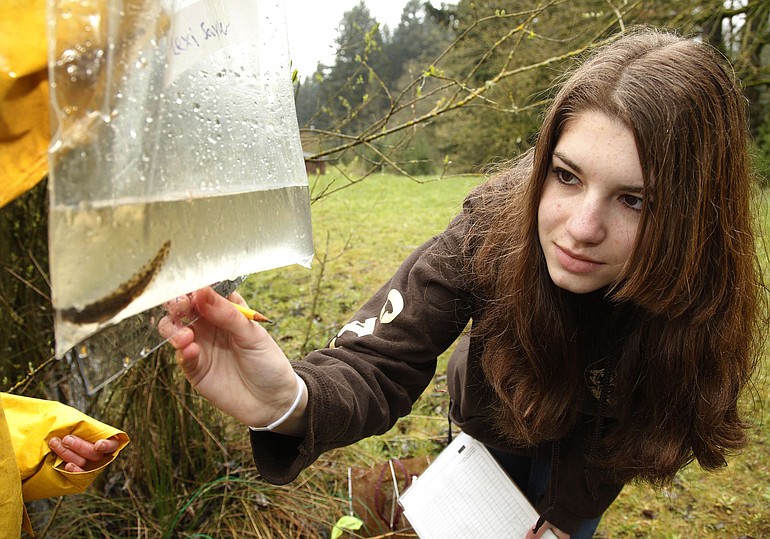BRUSH PRAIRIE — A driving rain provided ideal conditions for the amphibians living in the two ponds behind a set of high school classrooms.
Even though the conditions weren’t so great for the students in teachers Irene Catlin and Chris Collmer’s science class Thursday, three-dozen ninth-graders made the best out of the situation. The students collected traps containing native salamanders and non-native bullfrogs, part of a six-year amphibian monitoring study conducted at the Battle Ground school district’s unique natural area.
The chilling rain didn’t seem to faze them.
“I like being outside rather than in a classroom or a lab,” said Tristin Hongel, a Battle Ground High School freshman who says he’s interested in a career as an environmental engineer.
The simple yearning to be outdoors, directly experiencing the natural environment, would seem to be a trait shared by most scientific researchers.
Yet, for many adult researchers, conducting science in the field is becoming a lost art.
“We’re losing an entire generation of people … trained in natural history,” said Charlie Crisafulli, a U.S. Forest Service research ecologist who volunteers with the class.
Crisafulli said he agreed to work with the school six years ago after seeing a need.
Crisafulli, who lives in Yacolt, has spent 30 years studying the fast-evolving landscape in the blast zone of Mount St. Helens. Through the applications of post-graduate students interested in working with him, he’s watched as students have migrated into increasingly complex fields of scientific research. They’ve become adept at using GIS to catalogue data over vast landscapes, and they’ve zeroed in on the characteristics of life down to the molecular level. Applicants came in with highly specialized studies in botany, ornithology, ichthyology — “all of these ‘ologies,’” he said — but lacking in experience in basic field work.
“They know all these tools and gadgets, but they’re not experienced in the natural organisms,” Crisafulli said. “You need to know the players in order to really understand them.”
That’s where the Battle Ground program comes in.
The Center for Agriculture, Science, and Environmental Education, better known as the CASEE Center, includes an 80-acre site that includes the two ponds, an old-growth forest and streams. It draws students for 2½ hours a day from both Prairie and Battle Ground high schools.
“This is kind of our outdoor lab,” Catlin said, adding that students benefit from the longer classes. “We don’t have the time constraints they have at the high schools.”
The amphibian study started six years ago after Crisafulli was contacted by then-teacher Gina Garlie, who has since left the district.
The ongoing study teaches students about the basics of scientific research.
They develop a research question, figure out the data they need, determine a sampling protocol (in this case, using 24 collapsible minnow traps), gather the data, manage the data for quality control, and then summarize their findings.
The information then is tallied in a database now spanning six years. Once-abundant native amphibians such as Pacific tree frogs have all but disappeared since 2005, while non-native bullfrogs have proliferated.
“They’re huge, and they just eat everything,” Catlin said.
For many students, conducting real-world research sparks an enduring interest. Catlin said one former student, now doing post-graduate work in college, has asked Crisafulli for a letter of reference.
“If you can take students out and show them what ecology is all about, it can really engage them,” Crisafulli said. “It can become a ‘Eureka’ moment.”
Erik Robinson: 360-735-4551, or erik.robinson@columbian.com.



